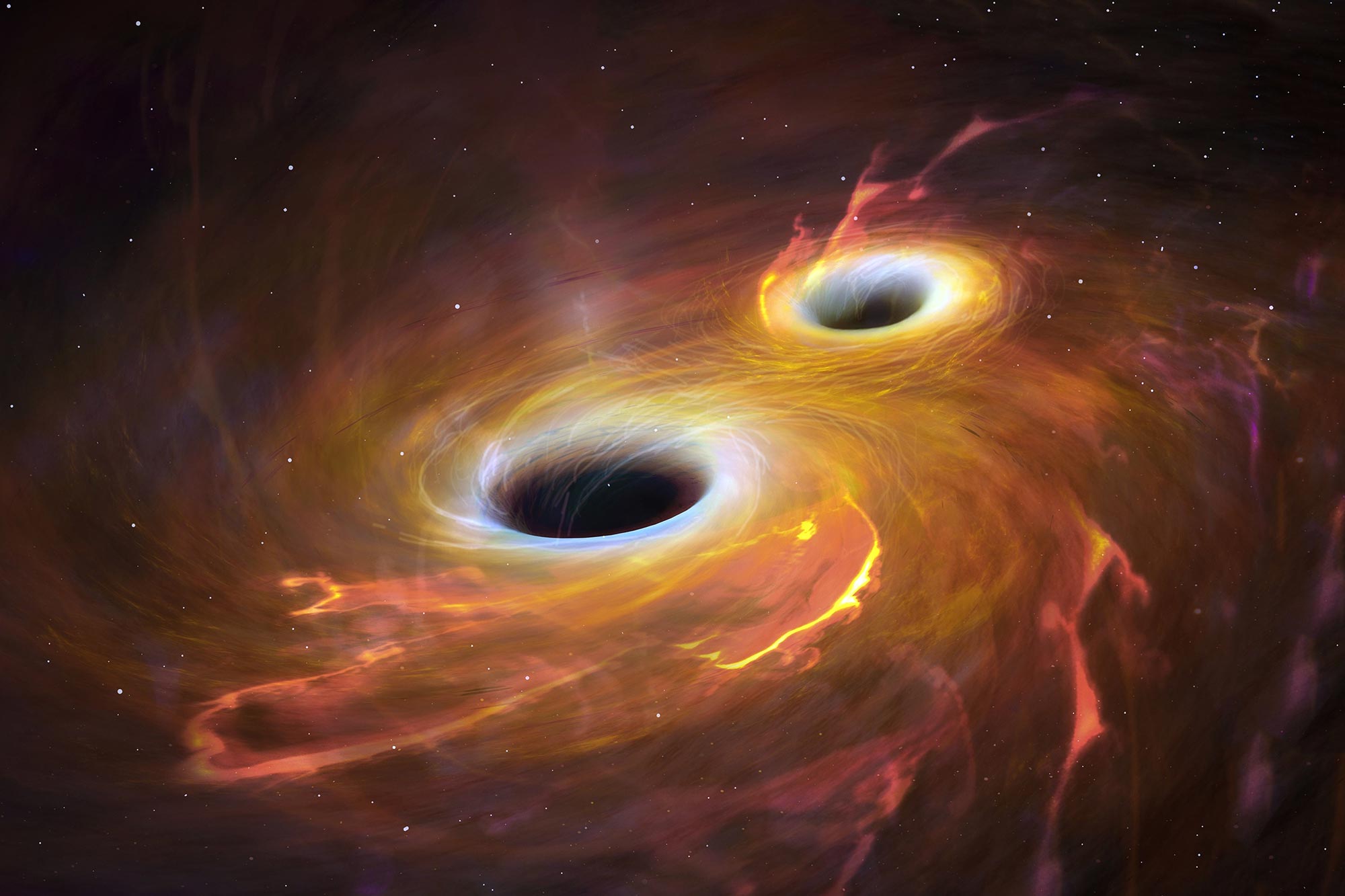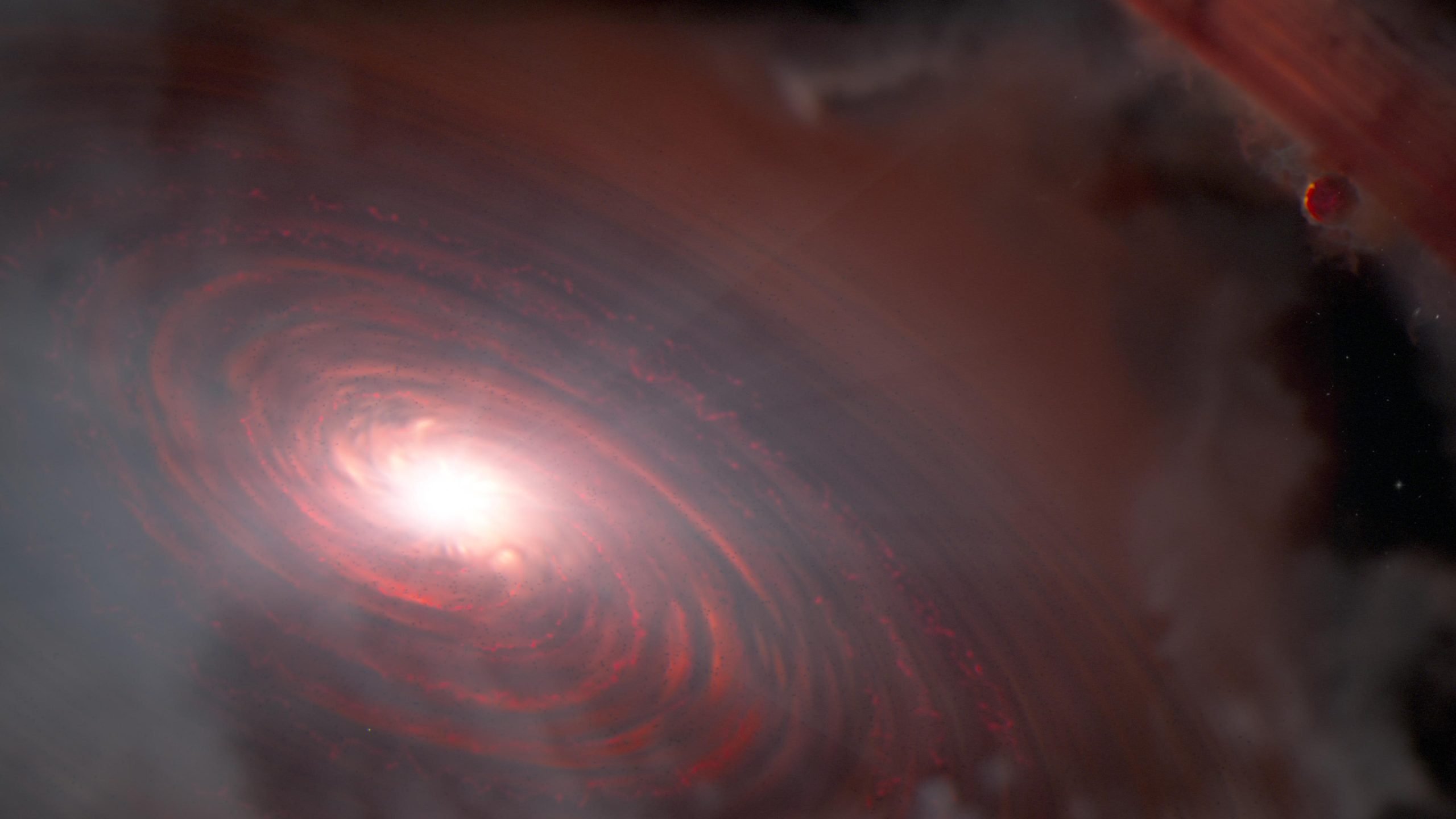
Impresión de un artista de dos agujeros negros a punto de chocar.
Nuevas observaciones y análisis revelan dos agujeros negros Goliat separados por solo 750 años luz y cerrándose mientras se rodean en una fusión de galaxias.
Los astrónomos del Instituto Flatiron y sus colegas vieron dos Goliat fantasmales en su camino hacia un encuentro desastroso. Un par de agujeros negros supermasivos recién descubiertos es lo más cercano que han visto a una colisión, anunciaron los astrónomos en un artículo publicado el 9 de enero en la reunión de la Sociedad Astronómica Estadounidense en Seattle. Las cartas del diario astrofísico.
Cósmicamente cercanos a una distancia de solo 750 años luz, los agujeros negros supermasivos no se fusionarán hasta dentro de varios cientos de millones de años. Mientras tanto, el descubrimiento de los astrónomos proporciona una mejor estimación de cuántos agujeros negros supermasivos también se acercan a la colisión en el universo.

La representación de este artista muestra la última etapa de la fusión de la galaxia y sus dos agujeros negros centrales recién descubiertos. Los agujeros negros binarios son los más cercanos jamás observados en múltiples longitudes de onda. Crédito: ALMA (ESO/NAOJ/NRAO); METRO. Weiss (NRAO/AUI/NSF)
Ese recuento mejorado ayudará a los científicos a escuchar el coro de ondas intensas en el espacio-tiempo conocido como[{» attribute=»»>gravitational waves, the largest of which are products of supermassive black holes close to collision in the aftermath of galaxy mergers. Detecting that gravitational-wave background will improve estimates of how many galaxies have collided and merged in the universe’s history.
The short distance between the newly discovered black holes “is fairly close to the limit of what we can detect, which is why this is so exciting,” says study co-author Chiara Mingarelli, an associate research scientist at the Flatiron Institute’s Center for Computational Astrophysics in New York City.
Due to the small separation between the black holes, the astronomers could only differentiate between the two objects by combining many observations from seven telescopes, including NASA’s Hubble Space Telescope. (Although supermassive black holes aren’t directly visible through an optical telescope, they are surrounded by bright bunches of luminous stars and warm gas drawn in by their gravitational pull.)

Telescope observations of two newly discovered supermassive black holes on a collision course. Their host galaxy, left, is a mash-up of two galaxies that have collided. The pink box shows the location of the supermassive black holes. Close observation of the pair, right, reveals two distinct black holes (white spots) only 750 light-years apart. Credit: M.J. Koss et al.
The astronomers found the pair quickly once they started looking, which means that close-together supermassive black holes “are probably more common than we think, given that we found these two and we didn’t have to look very far to find them,” Mingarelli says.
The newly identified supermassive black holes inhabit a mash-up of two galaxies that collided around 480 million light-years away from Earth. Gargantuan black holes live in the heart of most galaxies, growing bigger by gobbling up surrounding gas, dust, stars, and even other black holes. The two supermassive black holes identified in this study are true heavyweights: They clock in at 200 million and 125 million times the mass of our sun.
The black holes met as their host galaxies smashed into each other. Eventually they will begin circling each other, with the orbit tightening as gas and stars pass between the two black holes and steal orbital energy. Ultimately the black holes will start producing gravitational waves far stronger than any that have previously been detected, before crashing into each other to form one jumbo-size black hole.
La representación de este artista muestra la última etapa de la fusión de la galaxia y sus dos agujeros negros centrales recién descubiertos. Los agujeros negros binarios son los más cercanos jamás observados en múltiples longitudes de onda. Crédito:[{» attribute=»»>ALMA (ESO/NAOJ/NRAO), M. Koss et al (Eureka Scientific), S. Dagnello (NRAO/AUI/NSF)
Prior observations of the merging galaxies saw only a single supermassive black hole: Because the two objects are so close together, scientists couldn’t definitively tell them apart using a single telescope. The new survey, led by Michael J. Koss of Eureka Scientific in Oakland, California, combined 12 observations made on seven telescopes on Earth and in orbit. Although no single observation was enough to confirm their existence, the combined data conclusively revealed two distinct black holes.
“It’s important that with all these different images, you get the same story — that there are two black holes,” says Mingarelli, when comparing this new multi-observation research with previous efforts. “This is where other studies [of close-proximity supermassive black holes] han caído en el pasado. Cuando la gente los siguió, resultó que solo había un agujero negro. [This time we] Tengo muchas observaciones, todos están de acuerdo».

Representación esquemática de las etapas más importantes y los mecanismos físicos críticos que impulsan la fusión de dos agujeros negros supermasivos y sus respectivas escalas temporales y espaciales representativas. Crédito: José Utreras/Ezequiel Traister, Centro de Astrofísica y Tecnologías Afines (CATA); Michael Koss (Eureka Scientific) y col.
Él y el científico visitante del Instituto Flatiron, Andrew Casey-Clyde, utilizaron las nuevas observaciones para estimar la población de fusiones de agujeros negros supermasivos en el universo y descubrieron que «podría ser sorprendentemente alta», dijo Mingarelli. Predicen que hay una gran cantidad de pares de agujeros negros supermasivos que generan grandes cantidades de ondas gravitacionales superfuertes. Todo ese ruido debería resultar en un alto fondo de ondas gravitacionales que es mucho más fácil de detectar que si la población fuera más pequeña. Por lo tanto, la primera detección del ruido de fondo de las ondas gravitacionales podría ser «muy pronto», dice Mingarelli.
Referencia. «UGC 4211: Un Núcleo Galáctico Activo Binario Confirmado en el Universo Local a 230 de disociación nuclear» por Michael J. Koss, Ezekiel Traister, Darshan Kakad, J. Benny Trachtenbrot, Francisco I. Bauer, George S. Privon, Claudio Ricci, Richard Mussocki, Loreto Barcos-Munoz, Laura Blecha, Thomas Connor, Fiona Harrison, Tingting Liu, Macon Magno, Kiara M. Mingarelli, Francisco Muller-Sánchez, Cusezok, T. Taro Shimizu, Krista Lynn Smith, Daniel Stern, Miguel Parra Tello, and C. Megan Urry, 9 de enero de 2023 Las cartas del diario astrofísico.
DOI: 10.3847/2041-8213/aca8f0

Aficionado a los viajes. Lector exasperantemente humilde. Especialista en internet incurable
 Impulsse.la Complete News World
Impulsse.la Complete News World
